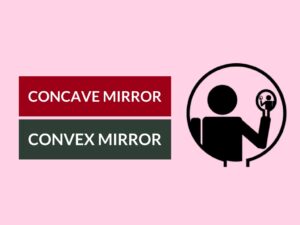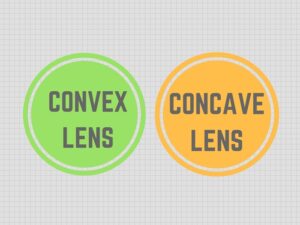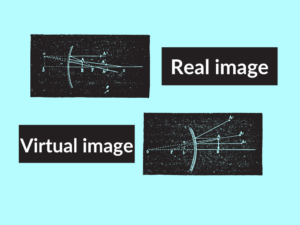What is Mirror?
A mirror is an object that reflects light and forms an image by preserving spatial dimensions such as shape, size, and orientation without significantly altering the wavelength of the light. Mirrors are made with a highly reflective coating, typically on a glass substrate.
Examples of Mirror:
- Plane Mirror
- Concave Mirror
- Convex Mirror
Uses of Mirror:
- Personal grooming (makeup, skincare)
- Scientific experiments and research
- Optical devices (telescopes, microscopes)
- Decorative purposes in interior design
- Enhancing the brightness of images
What is Lens?
A lens is a transparent optical device with two curved surfaces that refract light, focusing or dispersing the light rays to form an image. Lenses are commonly made of glass or transparent plastic and are classified into convex and concave lenses based on their shapes and ability to converge or diverge light.
Examples of Lens:
- Convex Lens
- Concave Lens
Uses of Lens:
- Correcting vision problems (eyeglasses, contact lenses)
- Microscopes and telescopes for magnification
- Cameras and projectors for image formation
- Scientific and medical equipment
- Focusing and dispersing light in optical systems
Differences between Mirror and Lens:
| Difference Area | Mirror | Lens |
|---|---|---|
| Shape | Mirrors have a flat or curved reflecting surface. | Lenses have two curved surfaces, either convex or concave. |
| Image Formation | Mirrors form virtual or real images with different characteristics. | Lenses form real or virtual images with varying properties. |
| Refraction | Mirrors do not refract light. | Lenses refract light, bending it at the interfaces. |
| Surface Coating | Mirrors have a reflective coating, commonly made of aluminum or silver, on one side of the glass. | Lenses do not have a reflective coating. They rely on the shape and refractive properties of the material. |
| Light Focusing | Mirrors do not focus or disperse light. They reflect it. | Lenses focus or disperse light, depending on their curvature, enabling image formation. |
| Thinness | Mirrors can be relatively thin depending on the application. | Lenses can be thicker than mirrors due to their geometry and refractive properties. |
| Reflection | Mirrors reflect light with minimal absorption. | Lenses refract light by bending its path. |
| Application | Mirrors are used extensively in personal grooming, optical devices, and decorative purposes. | Lenses find application in correcting vision, imaging systems, and scientific research. |
| Image Orientation | Mirror images are laterally inverted (left-right reversal). | Lens images have the same orientation as the object. |
| Converging or Diverging | All mirrors can only converge light. | Lenses can be either converging (convex) or diverging (concave), depending on their shape. |
Conclusion:
In summary, mirrors and lenses differ in their shape, image formation, refraction, surface coating, light focusing, thinness, reflection, applications, image orientation, and converging/diverging properties. Mirrors primarily reflect light, whereas lenses refract light to form images. Their unique characteristics make them useful in various fields, providing different optical functionalities.
People Also Ask:
- Question: Can a mirror be used as a lens?
- Question: Are all lenses made of glass?
- Question: Do lenses always invert images?
- Question: Can mirrors change the color of reflected light?
- Question: Can lenses make objects disappear?
No, a mirror cannot be used as a lens. Mirrors reflect light, while lenses refract light. They have different optical properties and cannot perform the same functions.
No, lenses can be made of glass or transparent plastic. The choice of material depends on the desired optical properties and application of the lens.
No, lenses do not always invert images. Converging lenses (convex) can produce both upright and inverted images, while diverging lenses (concave) always create virtual, upright images.
No, mirrors do not change the color of reflected light. They preserve the color of the incident light without altering its wavelength.
No, lenses cannot make objects disappear. They can only alter the direction and properties of light, but cannot remove or hide objects from view.




